#montanyes
Text

The Great Salem Fire of 1914
Salem, Massachusetts
On June 25, 1914 a devastating fire ignited on Boston Street in Blubber Hollow, the leather-manufacturing district of Salem. Over the course of two days, this massive fire destroyed 1,376 buildings and left 18,000 people, almost half of Salem’s population, homeless and many without jobs.
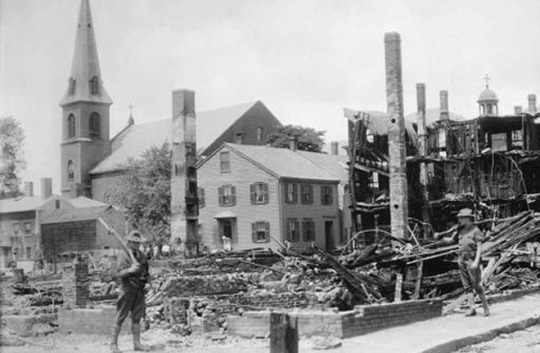
The Great Salem Fire started with a series of explosions, caused by a mixture of acetone, amalacitate, alcohol, and celluloid. At 1:37 PM, a fire alarm box was used to report a fire in the Korn leather factory, 57 Boston street.

The fire spread quickly down and across Boston Street. The police department sent out calls to 21 cities for assistance. One industrial department, the Fore River Shipyard, also assisted. Over 90 police men from out of town came to help. The Salem Evening News, (Friday, July 26, 1914, page 11), has a complete list of all responding departments and where and how they worked to fight the fire. The Salem Evening News covered the events in a series of articles which were later reprinted as a book by Montanye Perry
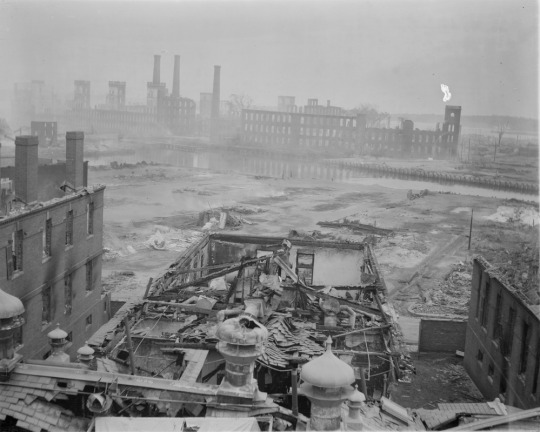
The fire burned 253 acres (1.02 km2; 0.395 sq mi) with 1,376 buildings. The entire loss was estimated at US$15 million; insurance policies paid US$11.744 million. Some 20,000 people lost their homes, 10,000 their jobs and a few their lives.
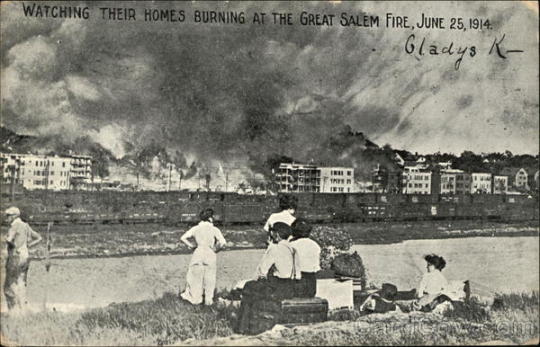
#ghost and hauntings#paranormal#ghost and spirits#haunted locations#haunted salem#myhauntedsalem#salem massachusetts#paranormal phenomena#Salem Fire of 1914
2 notes
·
View notes
Text
The Ghost of Captain James Byrd
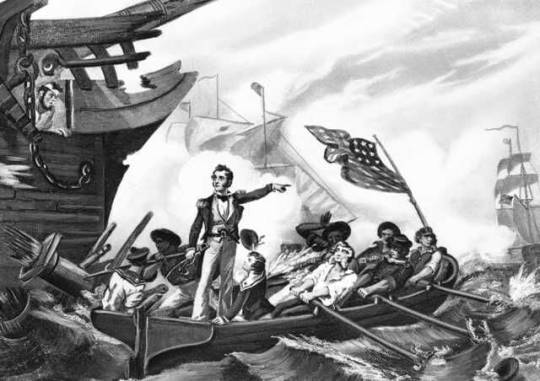
Photo provided by: Buffalo News
"Local legend, folklorists and supernatural guides have it that the old hotel on Hamburg’s shore – known for decades as Dock at the Bay and more recently as Dos Amigos – is haunted by the ghost of Captain James Byrd."
"The sad tale goes that Byrd was a member of Commodore Oliver Hazard Perry’s crew aboard the USS Lawrence, anchored off Hamburg’s shore during the War of 1812, and that Byrd regularly left the ship without leave for trysts with his girlfriend at the Willink Hotel, which is what the Dock at the Bay was called at that time.
When Perry learned of this desertion, according to the local legend, he ordered Byrd shot. And Byrd’s spirit now haunts the old hotel, the spirit guides say.
Like the telling of many old stories, there is some truth to this tale. But several of the facts became twisted with age and retelling. Nonetheless, the real story – though murky in some ways – is more tragic than the folklore.
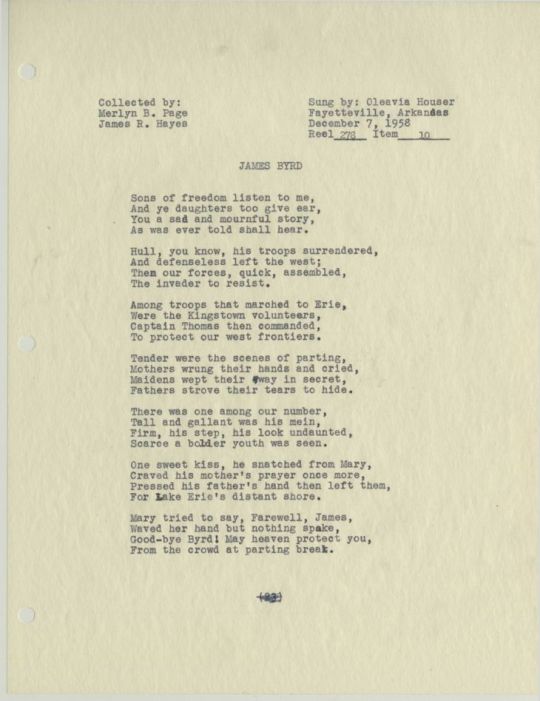
Photo provided by: Buffalo News
In fact, the true story generated much sympathy – even anger – among many Americans two centuries ago, and led to a ballad so popular that it was recited for decades by residents of Western New York, Pennsylvania and Ohio.
“In the early nineteenth century, when the new nation was still forging its identity, Bird’s heroism and subsequent death served the competing interests of partisan politics and national mythmaking while also reminding the postrevolutionary generation of the dangers of arbitrary power,” according to Traci Langworthy, writing in The Pennsylvania Magazine of History and Biography.
Newspapers and archives do record an execution on Lake Erie for desertion during the War of 1812. But the man’s name was James Bird. He was a soldier-marine. And he was a corporal.
Bird was arrested and then executed for desertion from Perry’s flagship, the Lawrence. That much is certain. But explanations for his desertion varied – from romantic to patriotic to pragmatic.
And by all accounts, he fought bravely a year earlier during the pivotal Battle of Lake Erie.
Bird was born Dec. 20, 1785, to John and Rebecca Montanye Bird.
He volunteered for the War of 1812 in the Wilkes-Barre area of Pennsylvania, where the family had moved, and was a member of a company of artillerymen that marched to Erie, Pa., according to the "History of Luzerne County." In Erie, Commodore Perry needed volunteers for his nine newly constructed ships that were to take on the British ships wreaking havoc on American settlements on Lake Erie. Bird volunteered as a marine.
During the Battle of Lake Erie in September of 1813 – famous for Perry’s after action report, “We have met the enemy, and they are ours” – Bird was aboard the flagship Lawrence. Though seriously wounded, he continued to fight valiantly.
“Towards the close of the engagement, a canister shot struck him on the shoulder as he was stooping to his gun,” The Wilkes-Barre Gleaner reported Nov. 16, 1813, in an account of Bird’s heroics during the battle. “He was instantly covered with blood, and his officer ordered him below. He ventured to disobey, preferring to do duty while he had life to abandoning his post. But the blood flowed so fast that another order was issued to go below. He ran down, got a hasty bandage on the wound, came again on deck and although his left arm was useless – yet he handed cartridges and performed the utmost service in his power with his right, until the stars and stripes waved gloriously over the foe.”
A year later, Bird had recovered from his wounds and was again a crew member of the Lawrence. It wasn’t long before he got into his fatal trouble.
He left the ship without leave.
One version of his desertion suggests a pragmatic explanation. He believed his enlistment was up.
“During the War of 1812, soldiers and sailors had little knowledge of military law and were tenacious of their rights as citizens,” Chautauqua County Historian Obed Edson explained in a paper delivered Sept. 19, 1913, to the Chautauqua Society of Historical and Natural Science.
Bird and some others thought they had enlisted just for the Battle on Lake Erie, according to Edson, so he and a few shipmates headed for home.
But the Americans were preparing for another battle with the British, an invasion of Canada, and one officer wanted to make an example of deserters. In this account, Bird and two others were arrested in Westfield and returned to the ship in Erie for court martial.
Then there is the patriotic explanation for the desertion.
That comes from the “History of Luzerne County.” Bird had learned of the intended attack on New Orleans and marched off with others to join Gen. Andrew Jackson’s forces, according to this version. He was apprehended in Pittsburgh and brought back for court martial.
“Poor fellow! Shot for an excess of bravery,” the author wrote.
The romantic explanation of Bird’s desertion comes from the folk ballad. The ballad has it that he left the ship to visit his sweetheart, Mary Blain, who was seriously ill, in Forsyth, Pa.
Where all these explanations agree is that Bird was tried and executed quickly after capture.
A court martial was hastily arranged, and Bird and two other deserters were condemned to death. An appeal to stay Bird’s execution until Perry – who was not in Erie at the time – could review the court martial was denied. One naval officer refused to sign his death warrant, but another officer did.
One of the deserters, a man named Davis, was hanged from the mast of the USS Niagara, while Bird and the third deserter, a man named Rankin, were forced to kneel over their coffins and shot on the ship’s deck.
“All three men were buried on the sandy flat at the entrance to the Erie Harbor,” Capt. Daniel Dobbins, who was present, later wrote,
On the day before he died, Bird wrote a farewell letter to his family that was printed in the Wilkes-Barre Gleaner soon after his execution. It reads in part:
“I am the most miserable and desolate child of the family – Dear Parents, let my brothers and sisters read this letter, for it is the last they can ever receive from my hand, for by the law of our country I am doomed and sentenced to death for deserting from the marines at Lake Erie ... . I have but a few moments to make peace with my maker. I leave you only for a short time here in this most troublesome world; but I hope that by the constant prayer we shall meet in the world above.”
Bird gave no explanation for his desertion, and he became a martyr to many. The pathetic story of James Bird was familiar to all living along the frontier, and was commemorated in the ... ballad written in sympathy with popular feeling,” according to the Centennial History of Chautauqua County. “For many years it was the most popular of ballads. It was so often sung and repeated as to be transmitted to the present time in many instances by the memory alone.”
The popularity of the ballad and the tyranny of his death resonated with many on the frontier for decades.
“One element of the ballad’s reception remained constant over time: the willingness of Bird’s admirers to overlook the youth’s potential flaws, lest they jeopardize his merits as a folk hero,” Langworthy wrote in The Pennsylvania Magazine of History. “Over time, the ballad nearly became secondary to the anecdotes surrounding it, and the “truth” of the young marine’s life became as malleable as its meaning.
While some may claim that James Bird’s ghost haunts a hotel in Hamburg, residents in northeastern Pennsylvania claim his remains.
He was reburied in Forty Fort Cemetery, Wilkes-Barre, in 1935 with a monument dedicated by the Luzerne County Chapter of Daughters of 1812.”
13 notes
·
View notes
Text
6 notes
·
View notes
Photo

The Man Who Never Forgot by C.S. Montanye Early Stories of thieves, murderers, and the occasional psychic. www.pulpfictionbook.store https://www.instagram.com/p/CmQD_0BrsLj/?igshid=NGJjMDIxMWI=
0 notes
Photo

Santuari de la mare de Déu del Fau #montanyes #altamontanya #santuarimarededeudelfa#altempordà #girona #pirineus #pirineos #pirineugirona #pirineucatalà (en Tapis, Cataluna, Spain) https://www.instagram.com/p/BoKGWAyA9dZ/?utm_source=ig_tumblr_share&igshid=h52qlwqke6n9
#montanyes#altamontanya#santuarimarededeudelfa#altempordà#girona#pirineus#pirineos#pirineugirona#pirineucatalà
1 note
·
View note
Photo

Matagalls, cobriza con una buena corona de espuma con gran retencion, aromas a malta tostada con ligeros toques afrutados y caramelo, lupulada con un cuerpo medio y una carbonatacion moderada. ♨️ IPA ⛽ 6,00% 🍺 60 IBU 🇬🇧 Matagalls, coppery with a good crown of foam with great retention, aromas of toasted malt with light fruity and caramel touches, hoppy with a medium body and moderate carbonation. #beertime #beerhunter #beers #beerphoto #cervesamontseny #matagalls #ipa #redipa #montseny #catalunya #montanyes #beer #bier #cervesa #cerveza #cerveja #birra #biere #öl #mitypa #starköl #ilovebeer #beerlover #beerporn #beerstagram #beerstagram #craftnotcrap #craftbeer #beerblog #beerblogger #spain🇪🇸 https://www.instagram.com/p/CHGlOMfJBxN/?igshid=1ri5sosoimcgq
#beertime#beerhunter#beers#beerphoto#cervesamontseny#matagalls#ipa#redipa#montseny#catalunya#montanyes#beer#bier#cervesa#cerveza#cerveja#birra#biere#öl#mitypa#starköl#ilovebeer#beerlover#beerporn#beerstagram#craftnotcrap#craftbeer#beerblog#beerblogger#spain🇪🇸
0 notes
Photo

@spokting @vanessa_instant ・・・ ⏺️Bon dia ⏺️Buenos días ⏺️Good morning ⏺️Bonjour . . . #covadonga #montanyes #alba #amanecer #nubes #montañas #picosdeeuropa #bigmountains #asturias #igersasturias #asturias_mola #asturiasgrafias #asturias_ig #estaes_asturias #viatgersdc #catalanspelmon #estaes_cielos #asturias_nature #asturiasgram #asturiasparaisonatural #turismoasturias #asturias_igers #ok_asturias #ok_spain #ok_sunset #igers_spain #spainstagram #spaintourism #spain_gallery #spain_vacations https://www.instagram.com/p/B4NApPAJ46A/?igshid=155cgjhcg188h
#covadonga#montanyes#alba#amanecer#nubes#montañas#picosdeeuropa#bigmountains#asturias#igersasturias#asturias_mola#asturiasgrafias#asturias_ig#estaes_asturias#viatgersdc#catalanspelmon#estaes_cielos#asturias_nature#asturiasgram#asturiasparaisonatural#turismoasturias#asturias_igers#ok_asturias#ok_spain#ok_sunset#igers_spain#spainstagram#spaintourism#spain_gallery#spain_vacations
0 notes
Photo

ebay
March 1945 issue
Seattle Mystery Bookshop
#benton braden#g.t. fleming-roberts#sam merwin jr#c.s. montanye#r. sprague hall#john l. benton#g. wayman jones#norman a. daniels#thrilling detective magazine#pulp art#pulp cover#pulp magazine#crime fiction#mystery short stories
10 notes
·
View notes
Text
Okay, that’s too many emotions for a day, I will see the other POV’s tomorrow, oh verge trobada entre montanyes que has fet???
back to answer asks again
14 notes
·
View notes
Text
L’Escola d’Olot, una “Fake News” amb 150 anys d’història. Fundació Vila Casas
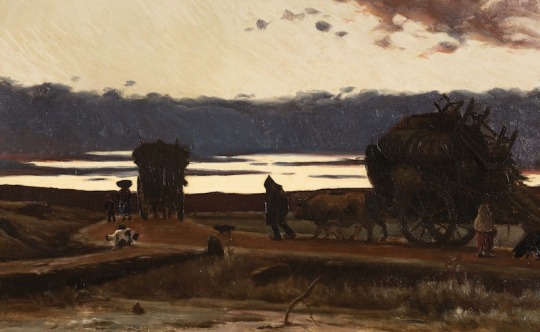
J. Vayreda_Recança. 1876
Ell (Joaquim Vayreda) no pintaba al davant del natural: se l’enduia, s’el gravava al cervell, l’acariciava i l’escollia per dintre; i en arribar al seu estudi, de les visions de tot el dia, de tot l’any, de tota la vida contemplativa, en buidava, a sobre la blanca tela, els raigs de llum, de verdor i de poesia que havia anat recollint en ses llargues oracions a les montanyes; sortia al camp a banyar-se l’esperit, corria les frondositats dels boscos,(...); i, sadollat de visions, paria a soles, com fruit ditxós de la terra. (Santiago Rusiñol, La Veu de Catalunya, 1894).
Agora, nestes meses que semella que é posible saír do estado de pandemia no que está sumida a humanidade, a Fundació Vila Casas -atenta como sempre ás manifestacións presentes e pasadas da arte en Cataluña- vén de abrir nos Espais Volart dúas mostras totalmente dispares. Unha delas da obra actual de Antoni Llena, e outra ben curiosa titulada L’Escola d’Olot, una “Fake News” amb 150 anys d’història. Que motiva que agora se procure desfacer un aserto totalmente aceptado? Hai algo que “molesta agora” dos traballos e creacións da saga familiar dos Vayreda e compañía?

Me. Domenge, Nena. 1890
A exposición L’Escola d’Olot, una “Fake News” presenta unha amplia variedade de pezas de pintura, e algunha escultura, das persoas que se dedicaron á creación artística desde mediados do século XIX. En total unhas 70 obras para dar boa conta das producións de quen sempre se tiveron por membros dunha escola artística consolidada e centrada na paisaxe da Garrotxa, tan especial en si mesma, pero que neste caso foi aínda idealizada. Para ter unha idea ben aproximada do contido desta mostra, paga a pena mirar este vídeo. A importancia que alcanzaron os pintores que traballaron na vila de Olot, mídese polo feito de que, ata mediados século XX, en cada casa da burguesía catalá colgaba, a lo menos, unha pintura dalgúns destes creadores de paisaxes. Hogano xa non é así; as modas mudan e os gustos tamén. Os descendentes de quen tanto estimaban as paisaxes idealizadas da Garrotxa agora prefiren outros artistas, outras tendencias estéticas. Será por iso que “agora e non antes” a Fundació Vila casas e mais Xavier Palomo, o comisario se atreven a afirmar que a Escola d’Olot é unha Fake News?
Que ven sendo unha escola artística? Difícil resposta. Requírese, quizais, unanimidade en eixos estéticos?, cómpre pescudar os mesmos temas, traballados baixo idéntico estilo? Tal vez se precise, tamén, que as persoas implicadas teñan conciencia da súa pertenza a ese grupo ou movemento. A reflexión, oportuna, leva á revisión de boa parte da historia da arte. As/os artistas do século XVII tiñan conciencia de seren artistas barrocos? A denominación que con total naturalidade se emprega para falar de pintura caravaggesca, ten sentido? Artemisia Gentileschi sabía que facía tal cousa?, ou Ribera, L’Espagnoletto, en Nápoles? As interrogantes pódense iniciar doutro xeito: quen decide que hai unha escola artística? Os críticos? Manter, a posteriori, que certo grupo de persoas conforman un grupo facilmente delimitable, unha escola, é doado ao presentarse certas condicións. E unha delas -posiblemente das máis importantes- sexa o límite no tempo. Defender que a Escola de Olot tivo/ten pervivencia ao longo dunha centuria semella excesivo.
Á chamada Escola de Olot preténdeselle dar carta de identidade a partir do paisaxismo, e dun uniforme trato do mesmo; cousa que se antolla inexistente.

Iu Pascual. Vent de Ponent. 1941
O paisaxismo na Escola d’Olot. Escola de Barbizon
Qui pogués amb vosaltres volar per les rouredes
que beuen les suades de l'aspre Pireneu,
i vora els banys de cignes d'aqueixes pollancredes
descabdellar lo somni que és vida del cor meu!
Ja es deuen prats i ribes cobrir de verds domassos,
cada turó amb la vesta de flors que més li escau,
la santa primavera per rebre entre sos braços
que amb nuvials adreços hi baixa del cel blau.
(Jacint Verdaguer, La Plana de Vic. 1875)
A pouco que se contemplen as pinturas dos irmáns Joaquim e Marian (Marià) Vayreda, ou Josep Berga i Boix, desaparecen as dúbidas sobre os temas e intereses destes pintores e activistas políticos e culturais radicados na vila interior de Olot. Cómpre ter en conta que, estes primeiros pintores do que logo se deu en denominar Escola d’Olot, eran de moi boa familia, xente moi acomodada, e que tiñan intereses en negocios de promocións urbasnísticas e tamén industriais. Por contra, nos seus lenzos bocólicos e descansados noutros tempos, nunca saíron fábricas, nin conflitos sociais. (neste senso, non deixa de ser estraño que o Museu de la Garrotxa -o museo de Olot onde descansan todas esas obras do paisaxismo olotí- tamén se atope a impresionante peza de Ramon Casas, La Càrrega, unha das mellores plasmacións plásticas do que é a represión sobre unha manifestación de obreiros.
Cara mediados do século XIX un grupo de pintores frecuenta os bosques de Fontainebleau para tomar apuntamentos directamente das paisaxes naturais. Algúns deles mesmo acaban por residir na pequena vila de Barbizon. Son un grupo -heteroxéneo, como todos- que quere reaccionar contra o romanticismo de Gericault ou Delacroix e presentar a natureza con tintas do que logo será o au plein air, tan do gusto dos impresionistas. Na escola de Barbizon mantense o estilo realista (como oposición ao romanticismo) para representar a paisaxe, que se capta, en notas, en directo e as telas son rematadas nos seus estudos. Ese proceso axuda a que o resultado final ofreza certas fasquías románticas. Entre os pintores de Barbizon sobresaen Camille Corot, como o máis xenuíno representante, e tamén Jean-François Millet. As paisaxes e escenas de traballo campesiño son ben coñecidas; duras. En concreto o seu Ángelus foi considerado por Salvador Dalí como a “biblia moderna”, e dedicoulle un libro ao estudo desa obra. A rotundidade das figuras de Millet amosan tamén en cadros dos Vayreda, como é o caso de Recança. A finais de 2019 -pouco antes de que se declarase como mal apocalíptico, arcano e ameazador a existencia dunha Pandemia mundial, a Fundación Mapfre presentou unha excelente exposición sobre a pintura con pastel (esa técnica que, en moitos casos e pexorativamente, reservouse ás mulleres). Nesa mostra púidose ver unha peza de Millet de magnífica factura.

Vayreda Canadell, Vall de Riudaura. 1950
Os Vayreda, mormente Joaquim, tiveron como mestre de pintura en Barcelona a Ramon Martí Alsina, paisaxista e entusiasta da escola de Barbizon. Desde entón moitos pintores de Olot (e de outroa recunchos de Cataluña) comezaron a pintar paisaxe. Pero esas paisaxes que saían dos pinceis dos Vayreda e compañía -como ben dixo Rusiñol, citado anteriormente- non eran pintados do natural, en directo, senón que, unha vez no seu estudo reflectían na tela els raigs de llum, de verdor i de poesia que havia anat recollint en ses llargues oracions a les montanyes. Paisaxes idealizadas.
Paisaxes idealizadas tinguidas de romanticismo e mediatizados por varias razóns. Por unha banda, Berga, Vayredas e outros botaban man de fotografías para logo reproducir con pintura escenas manipuladas. Como ben di o comisario, Xavier Palomo, eses pintores nunca montaron en burro para ir pintar do natural polas voltas da Garrotxa; e menos pisaron congostras e camiños enlamados por onde si pisaban, unha e outra vez, as persoas do campo que aparecen nas súas obras.
A intención destes primeiros pintores da chamada Escola d’Olot era vender a idea de que a súa comarca vivía, a mediados século XIX, unha paz bucólica, unha arcadia soñada, pero non real. A visión idílica, romántica do agro ten as súas orixes, por exemplo, nas poesías de mosen Cinto Verdaguer, o gran poeta da Renaixença. Para enxalzar a Cataluña reinventada cumprían imaxes que conmovesen, imaxes que a rica burguesía catalá e urbana mercaba con gusto, como xeito de reconciliación coa beatitude agraria, tan lonxe dos rebumbios das vilas industriais. Non se pode esquecer que nesta comarca da Garrotxa estaba moi presente o carlismo (son tempos de guerras carlistas; un dos Vayreda participará directamente), e concretamente os pintores citados, eran carlistas. Este bucolismo, xa que logo militante, acaía ben aos postulados carlistas, enfrontados á burguesía e á industria. Trátase por tanto de paisaxes dobremente identitarias.
A falsificación das paisaxes -aínda que con outros fines- ten unha longa historia. Quizais o caso máis salientable sexa o de Canaletto, o pintor veneciano, que nas súas veduta da cidade dos canais falsificou perspectivas e espazos: as prazas antóllanse moito máis grandes, as rúas e canais moito máis grandes. Cómpre constatar que as intencionalidades de Canaletto eran vender mellor a súa vila a tanta e tanto viaxeiro como comezaba a haber facendo o que se coñece como a Gran Tour; a viaxe das familias ricas do norte de Europa.
As persoas que se dedicaron á pintura artística nas voltas de Olot foron moitas desde mediados século XIX. E moitas delas seguiron coa tendencia de botar man do paisaxismo como xénero artístico. Artistas que seguiron as pegadas dos primeiros fixeron coma eles: nunca introducir nas súas paisaxes nin fábricas, nin conflitos sociais. Non! A Garrotxa vivía a perfección arcádica!
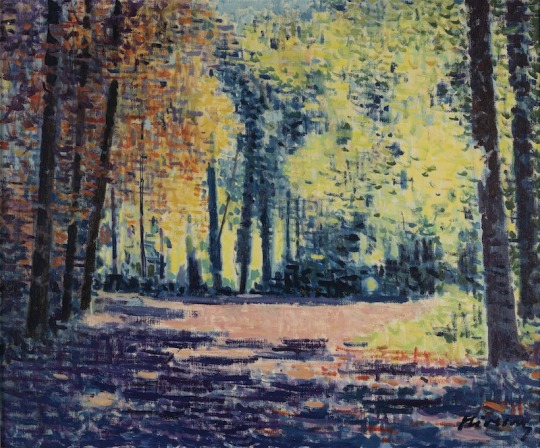
M. Oliveras. La Moixina, 1975
Pero tamén é certo que moitas persoas, aínda practicando o paisaxismo, xa non o fixeron dos xeitos idealizados que practicaran os primeiros Vayreda e Berga. Da saga Vayreda logo veñen outros membros, tamén artistas; entre eles Raymond Vayreda, un artista e promotor cultural da bisbarra que tamén foi amigo de Salvador Dalí e de outros artistas vangardistas. Na exposición L’Escola d’Olot, una “Fake News” amb 150 anys d’història están dispostas e vitrinas varias cartas de Dalí a este pintor, precisamente. E vida artística de Olot pasou por diversas tendencias, así como por tempos máis prósperos ca outros. Por exemplo, durante a ditadura de Primo de Rivera á Garrotxa chamóuselle a Suiza catalá, co que se volveu pretender idealizar a vida bucólica e perfecta. Outro tanto tornou a acontecer perante a ditadura franquista: a Garrotxa pasa a ser unha arcadia feliz, tal e como vén dicir a voz en off do NODO dedicado aos pintores olotíns e á súa comarca: donde los artistas no podían más que reflejar en sus obras la magnificencia natural de la sublime obra de Dios.
Sobre o tema da Guerra Civil e mais da ditadura franquista, hai agora mesmo en Barcelona a lo menos dúas exposicións que inciden claramente neses violentos e duros momentos do pasado. No Museu Nacional d’Art de Catalunya (MNAC) está a grande escolma de fotografías de Antoni Campañà (La guerra infinita. Antoni Campañà. Tensions d’una mirada (1906-1989)), un fotógrafo que -temeroso das represalias dos franquistas nada máis entrar en Barcelona, e de aí en diante- agocha miles de negativos de instantáneas que fixera polas rúas de Barcelona naqueles anos de guerra, por medo a que llas requisen para identificar aos “enemigos del nuevo régimen”. E, na galería Mayoral, volven estar presentes obras de Millares e mais de Rivera, dous dos artistas que fundaron o grupo EL PASO e que expresan nas súas obras a violencia, a rabia, a represión da ditadura franquista: Rivera-Millares. L’ètica de la reparació. En ambas escolmas artísticas sobrevoa a penumbra da Longa Noite de Pedra.
Lito Caramés
EXPOSICIÓN: L’Escola d’Olot, una “Fake News” amb 150 anys d’història
Espais Volart, Fundació Vila Casas
ata o día de Santiago de 2021
3 notes
·
View notes
Text
Oconomowoc gets two goals from Andritsch, beats Mukwonago
MUKWONAGO – It took a little while for Oconomowoc’s girls’ soccer team to find its rhythm on Tuesday night, but Louise Andritsch capitalized when they did.
The senior midfielder scored two first-half goals to lead the Raccoons to a 2-0 halftime lead over host Mukwonago, which was enough to carry her team to a 3-1 victory. Oconomowoc did not establish a consistent offensive flow until about 25 minutes in but was able to find the open spots down the stretch until halftime.
“Our first 45 (minutes) here was still a struggle, especially that first 15 minutes,” Raccoons’ coach Kayla Hottinger said. “We just kind of came out flat, so that’s something we need to fix. Once we settled in, things started going. We’re young. We only have two returning varsity players, so we just need to learn that when we score a goal, we have to put our foot down and keep going.”
Fellow senior midfielder Jadyn Rupnow added an insurance goal in the 70th minute after Indians’ sophomore forward/midfielder Chloe Butalla cut the deficit to one early in the second half.
“For us, it was a slow start and I think they all know they’re capable of more early on,” Mukwonago coach Dan Montanye said. “We certainly changed things up in that second half and put a lot of pressure on them. Got a quick goal to put us right back into it. Really proud of their effort level.”
Both teams had their share of offensive momentum in the first ten minutes. Oconomowoc sophomore midfielder Brianna Kehl got loose on a fast break in the first minute but was turned away by Indians’ sophomore goalkeeper Hailey Hartel. Raccoons’ junior goalkeeper Natalie Gricius had saves in the eighth and ninth minutes as well.
The next ten minutes were largely played in the middle of the field. Mukwonago then went on the attack, as senior forwards Kendyl Hagenbeck and Emily Glusick each fired shots that Gricius turned away. Gricius also saved a chance from the left side in the 23rd minute.
Oconomowoc got to work offensively from there. Hartel was busy from the 25th to 30th minutes, making four saves as the Raccoons played close to the Indians’ net. The flurry eventually paid off in the 32nd minute when Andritsch got free in a scramble near the left side of the net and fired in an easy shot to open the scoring.
“In this game, we were able to pick up our momentum in the middle, play through the middle and play to the wingers,” Andritsch said. “We found those open gaps and made shots on that.”
Andritsch and her teammates remained aggressive after that. She nearly scored again off a rebound but the goal was waved off an offsides call. One minute later, she lasered an unassisted deep shot from the left side through the net to double the lead before halftime.
“The second goal was just field awareness by Lulu,” Hottinger said. “She picked her head up to see the keeper was off her line.”
Mukwonago opened the second half with some momentum following a save by Hartel. The spurt paid off when Butalla booted a shot from the middle that snuck through Gricius into the net and got the home squad back in it.
“At the time, she was playing center-mid(fielder),” said Montanye of Butalla’s goal. “Sophomore and a good player. She didn’t shy away from any tackles and came up big, getting us right back into it. Credit to her. The ball just fell to her and she didn’t panic and put it in the back of the net.”
Glusick nearly tied the game 12 minutes later, but Gricius turned her away and Oconomowoc took over from there. A long shot from Rupnow got past Hartel but hit the right post in the 63rd minute before she scored the final goal seven minutes later.
2 notes
·
View notes
Photo

Wings For an Angel- Three Johnny Castle Novelettes by C.S. Montanye Johnny Castle was a sports reporter that seemed to always end up in the middle of a Murder case. Somehow, those bookies and agents and trainers all seemed to have an "angle". www.pulpfictionbook.store https://www.instagram.com/p/CmCheBBvWO8/?igshid=NGJjMDIxMWI=
0 notes
Photo

El Canigó #elcanigo #montanyes #altamontanya #caminar #caminare #caminatas #caminantes (en Canigou) https://www.instagram.com/p/Bn4QmWoA98S/?utm_source=ig_tumblr_share&igshid=rcjex9iaufm8
0 notes
Photo






The Great Salem Fire of 1914
On June 25, 1914 a devastating fire ignited on Boston Street in Blubber Hollow, the leather-manufacturing district of Salem. Over the course of two days, this massive fire destroyed 1,376 buildings and left 18,000 people, almost half of Salem’s population, homeless and many without jobs.
The Great Salem Fire started with a series of explosions, caused by a mixture of acetone, amalacitate, alcohol, and celluloid. At 1:37 PM, a fire alarm box was used to report a fire in the Korn leather factory, 57 Boston street.
The fire spread quickly down and across Boston Street. The police department sent out calls to 21 cities for assistance. One industrial department, the Fore River Shipyard, also assisted. Over 90 police men from out of town came to help. The Salem Evening News, (Friday, July 26, 1914, page 11), has a complete list of all responding departments and where and how they worked to fight the fire. The Salem Evening News covered the events in a series of articles which were later reprinted as a book by Montanye Perry
The fire burned 253 acres (1.02 km2; 0.395 sq mi) with 1,376 buildings. The entire loss was estimated at US$15 million; insurance policies paid US$11.744 million. Some 20,000 people lost their homes, 10,000 their jobs, and a few their lives.
18 notes
·
View notes
Photo

Foto amb el meu amic oscar cadiach, famos alpinista va fer cim en las montanyes mes altes del mon https://www.instagram.com/p/CheVPbPNf6-/?igshid=NGJjMDIxMWI=
0 notes
Photo

dtacollectables
August 1945 issue
cover art by Rudolph Belarski
Seattle Mystery Bookshop
#thrilling detective magazine#rudolph belarski#pulp art#pulp cover#pulp magazine#hardboiled#crime fiction#mystery short stories#c.s. montanye#robert martin#william rough
22 notes
·
View notes